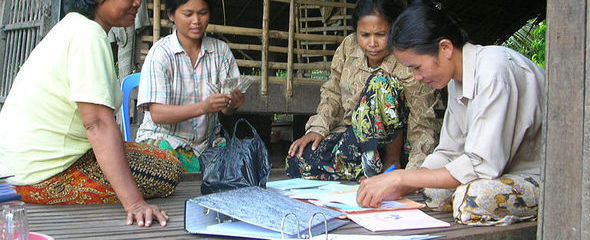5 Myths About Microcredit
Myth 1: Microcredit is a proven path out of poverty.

Microfinance was once a darling of international economics. Small loans between $50 and $500 to low-income individuals and small businesses were believed by many to offer a ladder out of poverty. But recently, microcredit has come under heat, often for inaccurate reasons. Here are five myths we need to overcome:
Myth 1: Microcredit is a proven path out of poverty.
As noted in a previous post, microcredit is not a guaranteed solution to poverty despite its widespread popularity in international development. Recent evidence comes from development economists using randomized controlled trials (RCTs), which can offer scientific confirmation of impact. Dean Karlan, a Yale economist and renowned microfinance scholar, emailed his thoughts to me recently:
"[Microcredit's benefits] are not what the biggest advocates hoped they would be, but some benefits have been observed. We find in India that loans to entrepreneurs did lead to higher business investment, but no increase in household income or consumption. In the Philippines, we observe a consolidation of businesses, but no higher income on average."
Myth 2: Without microcredit, poor people would have no access to credit.
Aishwarya Ratan, a researcher with whom I worked in India, cites a long list of alternatives to microcredit: money lenders, formal agricultural loans, chit funds, Rotating Savings and Credit Associations (ROSCAs), pawn brokers, cooperatives, landlords, and friends and family.
The upshot is that microcredit is far from the only credit option. What distinguishes microcredit is a constellation of traits. First, it explicitly claims to benefit poor clients. Second, it is typically provided by institutions outside of the community. Third, it tends to charge lower rates of interest relative to available options.
Myth 3: Microcredit borrowers only use the money on their businesses.
This myth is actively promoted by microcredit supporters, but it is only partially true. Borrowers also use loans to pay off other loans, to pay for events such as weddings and funerals, to pay for education, and to purchase a variety of goods and services. Business investments occur, but they are not necessarily the dominant use.
Of course, this doesn't mean that the other uses of microcredit aren't meaningful. In his book, One Illness Away, Duke University political scientist Anirudh Krishna documents household vulnerability to shocks. He wrote to me that "large, unforeseen expenses against which no insurance is available pitch people who were not poor before into poverty." Thus, the blow of sudden medical bills or a bad harvest can be softened by microcredit acting as post-hoc insurance.
Myth 4: The poor only need access to credit to pull themselves out of poverty.
I once met with Muhammad Yunus after a talk he delivered to some philanthropically minded technologists. In his talk, he adopted an avuncular tone and insisted that "given financial capital, the poor are fully capable of improving their lives." Yet, in private, he spoke earnestly of the mountains beyond mountains that his organizations have overcome to combat poverty. Yunus's own Grameen Bank, for example, has developed a complex initiation procedure for borrowers that involves oaths and lectures on the Bank's ethics. Lending occurs through borrowing groups, and every member of a new group must pass an exam about microcredit for the group to qualify. Groups meet regularly and enforce repayments through peer pressure. Meetings involve recitals of the "Sixteen Decisions" which extol children's education and latrine use among other things. In many villages, Grameen Bank partners with its sibling organizations to provide services in housing, healthcare, and so forth. Thus, even in Yunus's brand of microcredit, a lot more than credit is involved.
Related features -- sometimes called "hand-holding" -- are actually common practice among good microcredit institutions. Economist Greg Fischer presented one study at a microfinance conference last October which demonstrated the impact of even very simple support beyond credit to microentrepreneurs in the Dominican Republic. Under repetitive instructions to follow basic financial rules of thumb, borrowers were more likely to keep good books, separate personal and business accounts, and minimize hits to revenue during slow weeks.
Myth 5: Microenterprises are the way to grow an economy.Microcredit brochures often note that in many developing countries, the majority of the labor force is self-employed. Combined with Myth 3 above, the implication is that helping to grow microenterprises would also grow the larger economy. But research consistently shows that very few microenterprises ever make the leap to small or medium-sized businesses. For most microentrepreneurs, informal self-employment is a survival mechanism, not a choice. Limited education and entrepreneurial capacity mean that significant obstacles prevent them from becoming employed by formal institutions or graduating to larger, formal businesses. If microenterprises are a route to national growth, the mechanism is not yet clear.
[In a future post: which way for microcredit?]